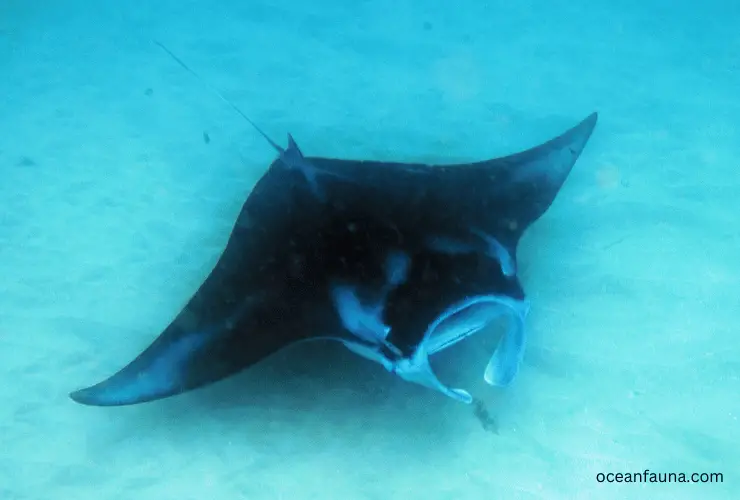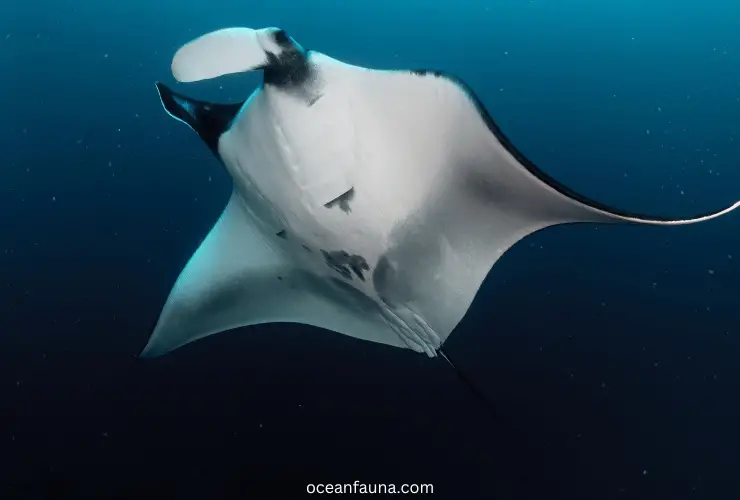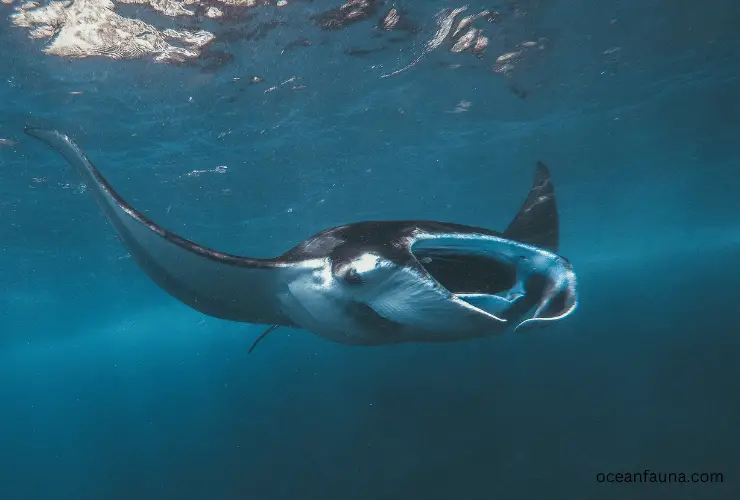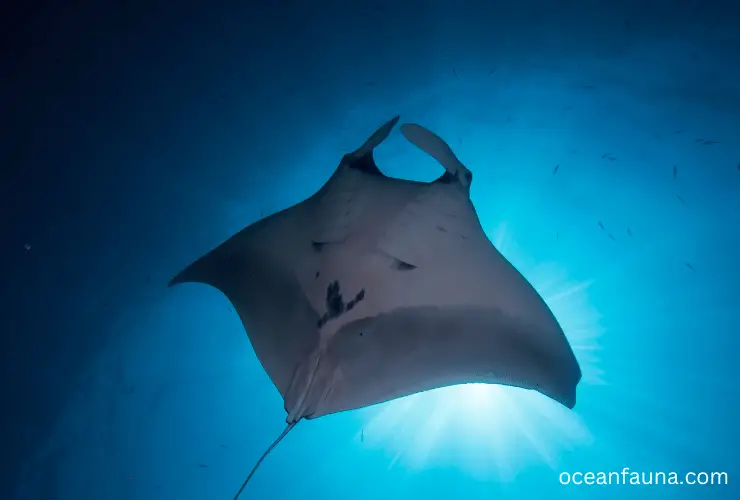Manta rays are a type of cartilaginous fish that produce live young by means of eggs hatched within the parent’s body. Male manta rays mate with their female partner, produce embryos and enable it to develop. They give birth to one or occasionally two offspring once every couple of years.
However, much about the reproductive habits of these animals remains a mystery. In this article, I will dive into the fascinating world of manta ray reproduction, exploring the latest research and insights into their mating habits and the lifecycle of their young.
By the end of this article, you’ll have a deeper appreciation for the incredible world of manta rays and the complexities of their reproduction. Stay tuned!!
At What Age Do Manta Rays Start Mating?

Manta rays reach sexual maturity between 8 to 10 years of age, although this can vary based on the species and geographic location. Once they reach sexual maturity, they can start mating.
And if the two species of Manta Rays are considered separately:
Giant Manta ray (Manta birostris): Males are known to reach sexual maturity at around 8-10 years of age, and females are thought to reach sexual maturity at around 10-15 years of age.
Reef Manta Ray (Manta alfredi): Males are known to reach sexual maturity at around 6-7 years of age, and females at around 8-10 years of age.
How Do Manta Rays Court with Each Other?
Manta rays have a unique courtship behavior that involves a series of aerial acrobatics and physical displays. During courtship, male manta rays follow females closely and swim in a zigzag pattern around them, while also showing off their fins and performing somersaults.
Males also make noises by clapping their pectoral fins together, which may attract females or signal their readiness to mate.
When a female is ready to mate, she will position herself upside down in the water and arch her back, exposing her ventral surface to the male. The male then uses his cephalic lobes, which are modified extensions of his pectoral fins, to grasp onto the female’s pectoral fins or ventral surface.
The two rays will swim together in a tight embrace, spiraling upward in the water column.
Mating can last anywhere from a few seconds to several hours, and females may mate with multiple males during a single reproductive cycle. After mating, the female will carry her fertilized eggs internally for several months before giving birth to live young.
How to Tell If Manta Ray Is Pregnant?
It can be difficult to tell if a manta ray is pregnant just by looking at them, as they have streamlined bodies, and their pregnancies are not always visibly apparent. However, a few physical and behavioral indicators can suggest that a manta ray is pregnant.
- A distended or swollen belly is one potential sign of pregnancy in manta rays: Pregnant manta rays may appear to have a rounder, more pronounced belly than non-pregnant individuals, although this can be difficult to discern without close observation.
- Another possible sign of pregnancy in manta rays is a change in behavior: Pregnant manta rays may alter their swimming patterns or feeding behavior as they adjust to carrying developing young. They may swim more slowly or erratically or spend more time near the water’s surface.
Suppose you are scuba diving or snorkeling near a manta ray. In that case, it is important to approach them carefully and avoid disturbing them, as they are sensitive creatures and can be easily stressed.

You should always give them plenty of space and avoid touching or chasing them.
If you are a researcher or marine biologist studying manta rays, you may be able to confirm pregnancy through ultrasound or other diagnostic techniques.
However, this is typically only feasible in a laboratory or research setting and is impractical for most recreational divers or wildlife enthusiasts.
What Is the Gestation Period? How Long Does Manta Ray Stay Pregnant Before Giving Birth?
The gestation period in manta rays refers to the length of time it takes for a female manta ray to carry and develop her offspring inside her body before giving birth to live pups.
During this period, the fertilized eggs develop and mature within the female’s body, and she provides them with the necessary nutrients and protection needed for their survival.
The gestation period is an important aspect of the reproductive biology of manta rays, as it can impact their population dynamics and reproductive success.
Manta rays have a relatively long gestation period compared to many other marine animals, lasting from 9 to 12 months, depending on the species.

During this time, the female manta ray carries the fertilized eggs inside her body until they hatch and then give birth to live pups.
Understanding the gestation period of manta rays is also important for conservation efforts. These species have a low reproductive rate and are vulnerable to overfishing and other human activities that can impact their populations.
Step-By-Step Process of Manta Rays Give Birth
Manta rays give birth to live pups through a process known as ovoviviparity. Here is a detailed description of the full process step by step:
Birth
When the pups are fully developed and ready to be born, the female manta ray will find a calm and shallow area of water where she can give birth safely.
Positioning
The female manta ray will typically position herself close to the water’s surface and begin to deliver the pups one at a time.
Tail-first delivery
The pups are born tail-first, and the female manta ray will use muscular contractions to help push them out of her body.
Independence
Once the pups are born, they can swim and feed independently. They will quickly swim away from their mother to begin their independent lives.
FAQs
Do Manta Ray Babies Stay with Their Mothers?
Manta rays babies do not stay with their mothers after birth. Once the pups are born, they are on their own and must fend for themselves. The mother, the manta ray, provides no care or protection for her offspring.
The pups must find their own food and learn to avoid predators in their environment. Manta rays are generally solitary creatures, so even adult manta rays do not typically stay together in groups or with their own offspring.
How Many Babies Do Manta Ray Give Birth in a Single Time?
Manta rays typically give birth to one or two pups at a time, although in rare cases, they may give birth to as many as three or four. The number of offspring a manta ray can have in its lifetime varies depending on age, size, and reproductive success.
Manta rays are slow to reach sexual maturity and have a relatively low reproductive rate, with females typically giving birth to only one or two offspring every two to five years.
Therefore, over the course of its lifetime, a manta ray may give birth to anywhere from just a few to several dozen offspring, depending on its lifespan and reproductive success.
Conclusion
Manta rays give birth to live young, and the size of the newborns varies depending on the species. The smaller reef manta ray (Manta alfredi) typically gives birth to pups that are between 0.6 to 0.9 meters (2 to 3 feet) in wingspan.
In comparison, the larger oceanic manta ray (Manta birostris) gives birth to much larger pups, with a wingspan of around 1.5 to 1.8 meters (5 to 6 feet).

